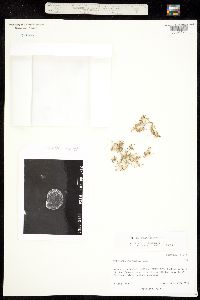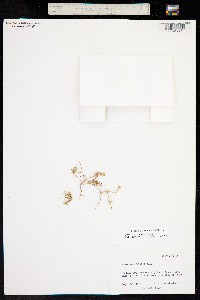Portulaca halimoides
|
|
|
|
Family: Portulacaceae
Silk-Cotton Purslane, more...silkcotton purslane, sinkerleaf purslane
[Portulaca martinicensis Urb., morePortulaca parvula A. Gray] |
Plants annual; roots fibrous. Stems prostrate to suberect, often pinkish, succulent; trichomes conspicuous at nodes and in inflorescence; branches to 3-20(-25) cm. Leaf blades linear to oblong-linear, terete to hemis-pheric, 2-14(-20) × 0.4-2(-3) mm, apex obtuse to acute; involucrelike leaves 4-8. Flowers 3-8 mm diam.; petals yellow, obovate, 2-4 × 1-2.5 mm; stamens 4-18; stigmas 3-4(-5). Capsules ovoid, 1.1-2 mm diam. Seeds gray or leaden, 0.3-0.5(-0.6) mm diam.; lateral surfaces with densely arranged, flattened, stellate cells, tubercles absent; usually with a smooth, occasionally papillose, spine abaxially. 2n = 18. Flowering late spring-early fall. Dry soil, sand dunes, arroyos; 900-2300 m; Ariz., Calif., Colo., Nev., N.Mex., Okla., Tex., Utah; West Indies; Central America; South America. Young plants of Portulaca halimoides in desert areas may exhibit reddish stems and sepals. As the yellow petals fade, the persistent, reddish sepals cover the top of the capsule, giving the false impression of red flowers. Immature seeds are reddish brown to brownish black and may be papillose. Morphologic variability occurs in relation to habitat differences over the range of this species. Desert conditions produce depauperate plants; more robust specimens occur in Central America and South America. The type of P. halimoides is conspecific with P. parvula A. Gray within this context. A. Gray (1887) cited P. halimoides from the Florida Keys; that is unconfirmed and is likely a confusion with P. rubricaulis.
PLANT: Annual herbs from a slender, fibrous root. STEMS: much branched, prostrate to somewhat ascending, 2-16 cm long, often reddish, glabrous. LEAVES: alternate, linear, cylindrical or nearly so, 4-15 (18) mm long, 0.5-3 mm wide; nodes with conspicuous white-villous hairs. INFLORESCENCE: white-villous; involucral bracts 6-8, 3-8 mm long, 0.5-3 mm wide. FLOWERS: solitary or clustered at the ends of branches; sepals typically turning reddish at maturity; petals 2-2.5 mm long, yellow to copper colored; stigmatic branches 3-4. CAPSULE: 1-2 mm in diameter; stipe 1-1.5 mm long. SEEDS: iridescent grayish or blackish at maturity, rounded or stellate-tuberculate. NOTES: Sandy or gravelly soils, in open or brushy sites, often in disturbed places: Cochise, Coconino, Graham, Greenlee, Maricopa, Mohave, Navajo, Pima, Pinal, Santa Cruz, Yavapai, Yuma cos.; 350-2050 m (1100-6800 ft); Mar-Nov; MO to CO; s to TX and NM. REFERENCES: Allison Bair, Marissa Howe, Daniela Roth, Robin Taylor, Tina Ayers, and Robert W. Kiger., 2006, Vascular Plants of Arizona: Portulacaceae. CANOTIA 2(1): 1-22. Bair et al. 2006, Martin and Hutchins 1980, FNA 2003 Duration: Annual Nativity: Native Lifeform: Forb/Herb General: Succulent annual herb from slender, fibrous roots; stems decumbent to somewhat ascending, 2-16 cm long, much-branched, often reddish, glabrous. Leaves: Alternate along the stems and nearly sessile, with white hairs in the axils; blades succulent, linear, cylindrical (terete) or nearly so, 4-15 mm long and 0.5-3 mm wide. Flowers: Yellow to orange, solitary or in small clusters at tips of stems; each flower cluster subtended by a whorl of 6-8 leaves and a tuft of long white hairs; sepals 2 per flower, turning red at maturity; petals 5 per flower, 2-3 mm long, yellow to copper-colored or reddish. Fruits: Capsule globose, 1-2 mm in diameter; splitting open so that the top comes off like a pot lid (circumcessile dehiscence) to release many red or black seeds. Ecology: Found in sandy or gravelly soils, in open to brushy sites, often in disturbed areas, from 1,000-7,000 ft (305-2134 m); flowers March-November. Distribution: MO to CO, south to OK, TX, NM, se AZ, and MEX. Notes: This small succulent annual is distinguished by its minute flowers with yellow to copper colored petals; reddish stems and green cylindrical leaves; and the pair of reddish sepals that remains visible after the flowers fade. Look also for the tufts of white hair at the base of the flowers and a few hairs at the leaf axils as well. When it doesn't have flowers it can resemble Halogeton glomeratus, but that species has blue-green leaves which are tipped with stiff sharp bristles. Ethnobotany: Unknown Etymology: Portulaca is from the Latin portula, little door, in reference to the the lid of the seed capsule; halimoides refers to a resemblance to the genus Halimium. Synonyms: Portulaca parvula Editor: SBuckley 2010, AHazelton 2017 |
|
|
|















































































